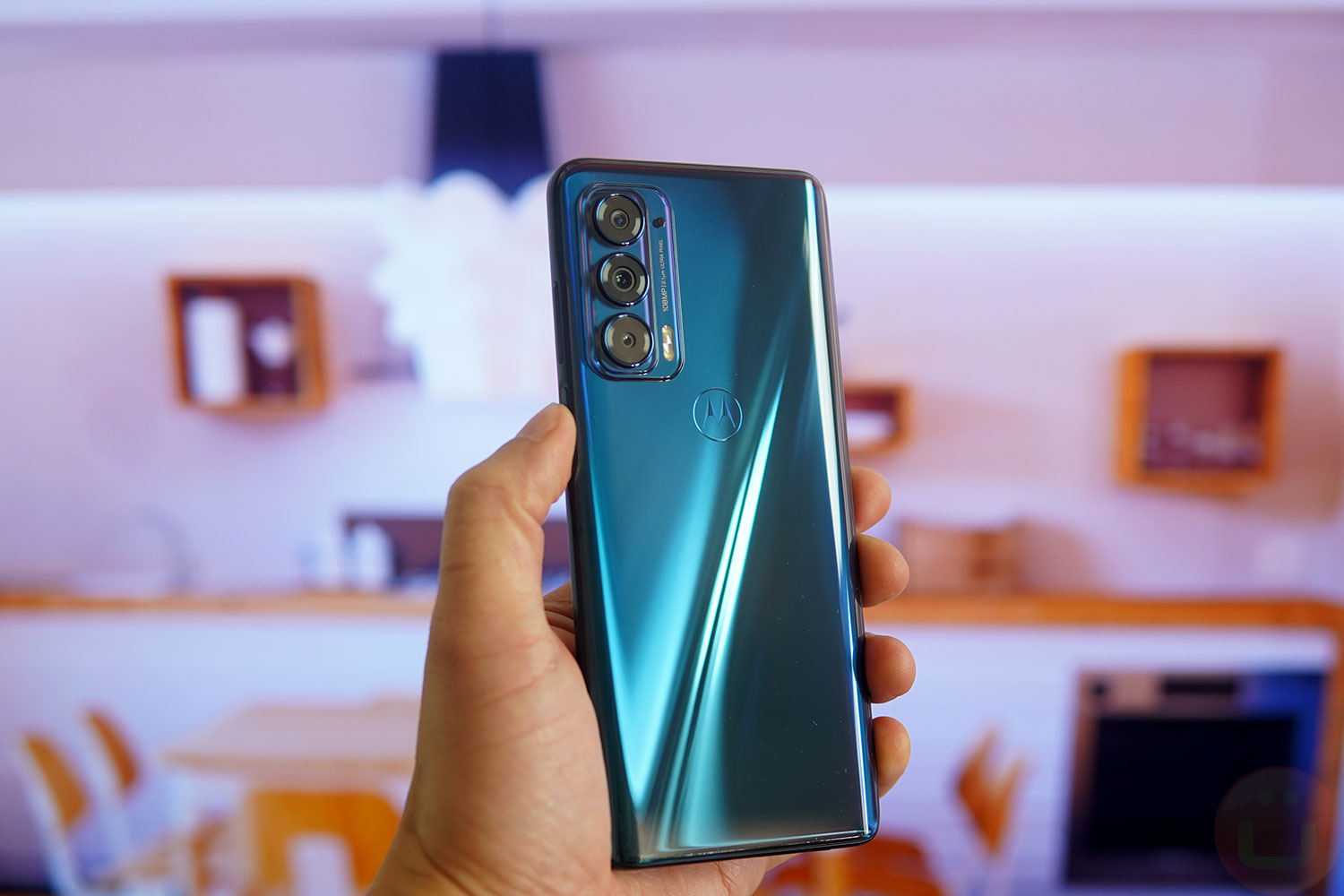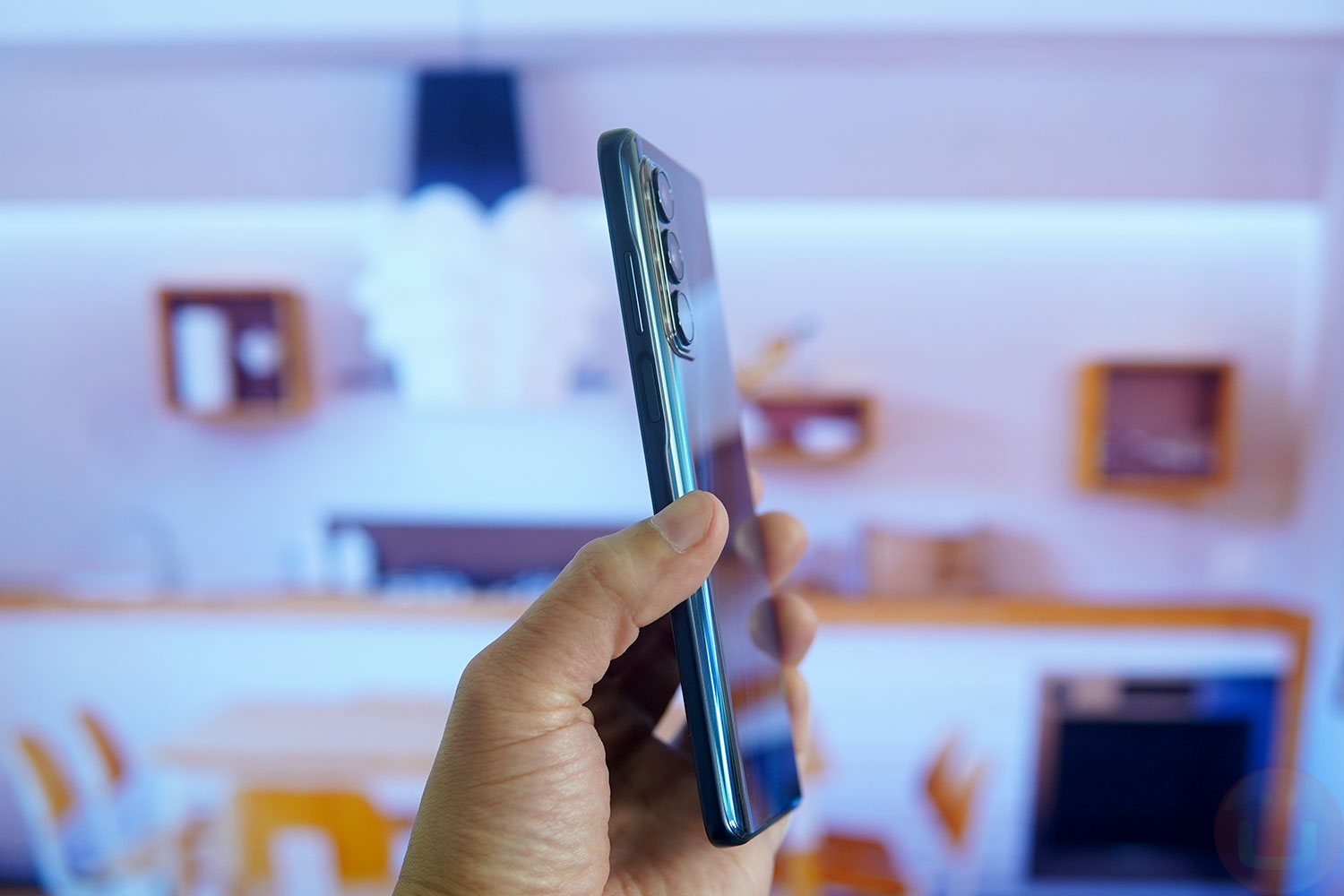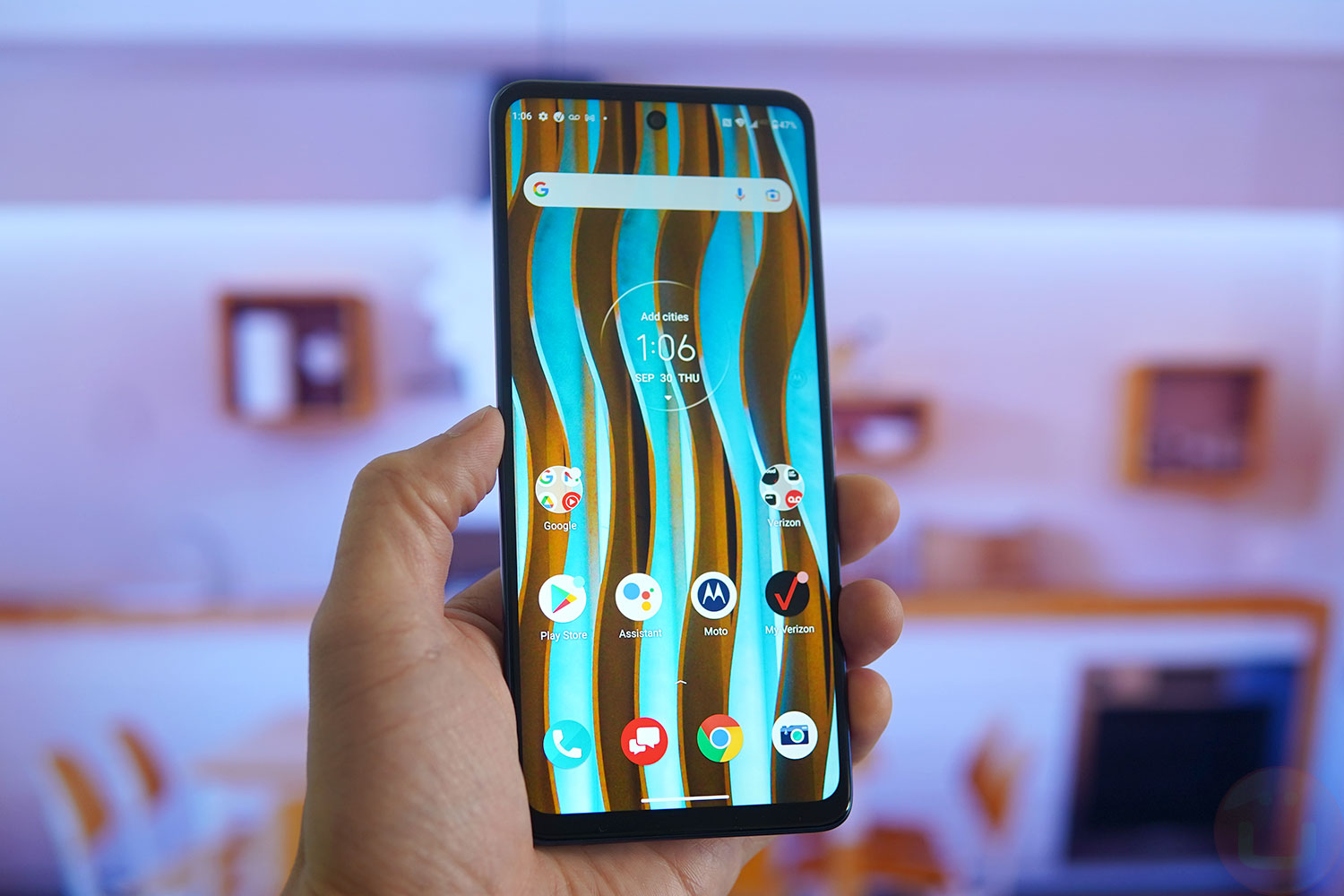
The Motorola moto edge gen2 (moto edge 5G UW) is a premium smartphone built to compete in the $599-$699 market segment where users still demand “premium” features such as 5G, a good camera, a large display, and good performance.
Customers want full multimedia experiences but might not want to spend much more to get the most advanced (and expensive) technologies. In short, it should be an outstanding balance between user experience (UX) and price.
Design

The moto edge is a large phone thanks to its 6.8-inch display, around which everything else is built. We’ll come back to the display performance and technicals later, but the bezels are relatively thin from a design standpoint, even though the chin might be a bit noticeable.
This smartphone has a very rigid aluminum chassis. It feels like a durable, well-constructed phone that doesn’t feel flimsy in hand. The with is agreeable to my S-size hands, but I’m used to having big phones.
Since we mentioned durability, it’s worth noting the IP52 IP rating, which means that it has some protection again dust and water splashes but is not dust-tight and should not be immersed in water.
I like the glass back cover with the iridescent blue color that I find elegant and visually agreeable. The glass surface is prone to retaining fingerprints, but it’s pretty common with glass. More expensive phones might have an oleophobic treatment, but in this case, I simply wipe it now and then.
There’s no 3.5mm audio connector, and it’s not a huge deal, but for a phone this large, it would have been convenient as heavy multimedia users might want to connect fancy headphones without an adapter.
The bottom-ported speaker sound quality is clear and without saturation. However, it is not as powerful as dual-speakers systems, and a side-by-side comparison would make this fairly obvious. For speaker calls and light multimedia usage, it’s fine, but if you want to crank it up to listen to music, you might find yourself wanting a bit more power and bass.
For example, the sound quality is comparable to the Pixel 5’s, but the Galaxy S21 has noticeably better audio, and the S21 Ultra is even better (and much more expensive), of course.
Display

Having such a large display (6.8-inch) makes any visual activity much more comfortable, whether it is games, movies, social media, or just reading text. Interacting with the phone feels very smooth, thanks to the high refresh rate (up to 144Hz) and the low touch-response latency (576 Hz sampling).
Note that if you play games or use the adaptive refresh, the maximum refresh rate will top at 120Hz. It’s not an issue in the real world since advanced 3D games might not reach that speed anyway, and even if they did, most people wouldn’t notice the difference between 120Hz and 144Hz.
The scrolling is super-smooth, and it’s shocking when you go back to a 60Hz smartphone, at least for a short while.
The display has a flat glass surface (I remember the gen1 being curvy), but I don’t mind. The main advantage of curved edge displays is to thin the left+right bezel as much as possible. However, there are potential downsides, such as touch false-positive.
The 120% sRGB color gamut is excellent, and the color accuracy is beyond what most people can spot. Technically, the display simply has great color rendering. That said, it seems to slightly over-saturate the image, even in “normal” color mode so perhaps there’s some image processing going on (the default mode is “saturated”).
Our unit’s brightness topped at 310 NITs during testing, which is not very high, but I’ve heard of others measuring ~500 NITs, which seems more in line with the specs. The low brightness may be an issue specific to the unit we have on hand.
Moto edge gen2 Camera

The new moto edge gen2’s rear camera system has undergone a significant configuration change, and it looks like Motorola tried its best to re-balance where camera resources are going.
Our CAMERA HW benchmark shows this very well: both the edge gen1 and edge gen2 obtain an overall camera hardware score of 141, which shows that changes were thought out very carefully. The CAMERA HW sub-scores reveal more:
| Edge gen2 | Edge gen1 | S21 | |
| Overall CAMERA HW score | 141 | 141 | 163 |
| Sub-primary score | 119 | 107 | 124 |
| Sub-ultrawide score | 33 | 39 | 60 |
| Sub-zoom score | [no zoom] | 35.9 | [unrated] |
Motorola has redirected resources towards the Primary camera module, which is the most important to the overall user experience. The new Ultrawide camera is technically slightly less performant, but it’s hard to spot from a perceptive standpoint unless you look very closely.
The gen1’s 2X zoom lens is no longer present on the gen2, but a lack of 51mm lens can be partially compensated by a better primary camera, so it’s not a dramatic loss. Overall, it might be a sensible choice since the Primary camera module is the most utilized anyway.
Not completely represented by the score is that the new ultrawide camera can also serve as a “macro” camera. Macro photography is a nascent use case that you don’t yet see very often (check your social media feeds), but there’s some potential, and we’re glad to see OEMs explore it.
We find the photo quality to be decent, and in very dim lighting, the image quality might be closer to the Google Pixel 4a 5G and isn’t as high as the Galaxy S21 primary camera. The smaller 0.7-micron sensor pixels (probably the Samsung S5KHM2) required to reach the dizzying 108MP native resolution is an asset in daylight but could be a liability in low-light.
Also, the 108MP photos are only available in a particular “Ultra-Res” mode, and we would rather see it as part of the “auto” mode, as people are less unlikely to switch. By default, all photos are saved in 12 MP for all cameras and the 108MP sensor is a bit under-utilized in daylight photos as extra details (an essential aspect of objective image quality) could be captured and saved.
Still, from a value standpoint (quality/price), the moto edge’s camera stands its ground, especially if you can buy it for 599.99 or less since the Galaxy S21’s MSRP is 799.99.
Moto Software
The moto edge runs on Android 11, and Motorola tries to keep the bloat to a minimum, even if it has some proprietary apps, like its “Moto” app, a people-friendly system settings manager.
Motorola also has Moto Actions, a series of convenient gestures to quickly perform everyday tasks. They include twisting the wrist twice to open the camera, Reaching the phone to update and display the notifications, or a chopping motion to turn the flashlight ON and OFF. I also like the three-fingers screenshot.
"MOTOROLA TRIES TO KEEP THE BLOAT TO A MINIMUM"This smartphone can also use Motorola’s Ready For, which can connect the phone to a Miracast TV and use it as an external monitor. It is pretty convenient to play games, share photos, play videos, or Powerpoint presentations.
If you work for a company that is ready to subsidize a work phone, ThinkShield might reassure your IT department as it passes many certifications required for enterprise usage. If this is the phone you want, it might be worth asking your IT department.
The phone comes with 256GB of storage for apps and data, which should be sufficient for most users. If you start downloading many HD movies, things might get tight, but people usually don’t keep movies locally after watching them. Unfortunately, there’s no additional micro-SD storage to extend the capacity cheaply.
System performance
This moto edge is powered by Qualcomm’s Snapdragon 778G 5G, a great processor platform primarily used in the $400-$550 market segment, giving a good performance/price ratio.
At an MSRP of $699.99, the performance value-proposition of the moto edge gen2 is not optimum, but the multimedia user experience (including casual games) is generally very good. For this phone, we’ve seen street prices of $599.99 that substantially change the value proposition.
Gamers who want to play more advanced games will be glad to know that the moto edge gen2 is substantially faster than the first moto edge (2020), with 73% faster graphics in our tests. The previous version had about the same performance as the Google Pixel 5, one of the handsets most commonly compared with the moto edge family.


That said, our data also shows that hardcore gamers will find better absolute performance and better performance/price ratios with smartphones powered by high-end processors, such as the Galaxy S21 (Snapdragon 888) or the iPhone 12 (A14).
That said, the Snapdragon 778G’s performance is entirely honorable, and it has support for Snapdragon Elite Gaming, just like more expensive phones.
Moto Edge 2021 Battery Life

The 5000 mAh battery capacity is excellent and pretty much the maximum you’ll find in classic smartphones today.
I recommend everyone to use the displays’ 120 HZ “auto” mode that lowers the refresh when you’re not actually scrolling. The adaptiveness will significantly reduce power consumption nearly to the level of a 60 Hz display. In short, I couldn’t find a good use case for switching to always-on 144 Hz.
"IN SHORT, THE BATTERY LIFE IS EXCELLENT"You should get a very long day of battery life with standard usage. For everyday productivity tasks, battery benchmarks should yield a high 10 to 11 hours of use. Motorola claims up to 2 days of battery life and it might be possible in some cases. In short, the battery life is excellent!
In theory, the moto edge supports up to 30W wired charging, which is quite fast. However, the charger is not provided in the box, so you might want to check what you have at home.
If you have purchased a fast-charging power adapter, perhaps something like the Anker Nano II 30W would be ideal. I have not tested it yet, but the specs look good, and it is tiny. For reference, and at 30W, the moto edge charges 38% faster than the iPhone 12 Pro Max.
Conclusion
The moto edge gen2 is a significant improvement over last year’s moto edge gen1. The camera prioritizes the most common use cases while system performance is much better. Motorola has worked on the right things.
The design is agreeable, and the large display makes it an excellent entertainment phone that has very decent gaming performance. I like the fast display refresh rate and re-iterate my advice of using the 120Hz in “auto” mode rather than 144Hz.
The $699.99 MSRP price makes it significantly more affordable than the Galaxy S21, but there is plenty of potent competition in this price range. However, if you go to Motorola’s site or browse around (or on amazon), you can find it selling for $599.99 (we did at publishing time), making the moto edge much more attractive.
Filed in . Read more about Android, Motorola and Smartphone Reviews.






